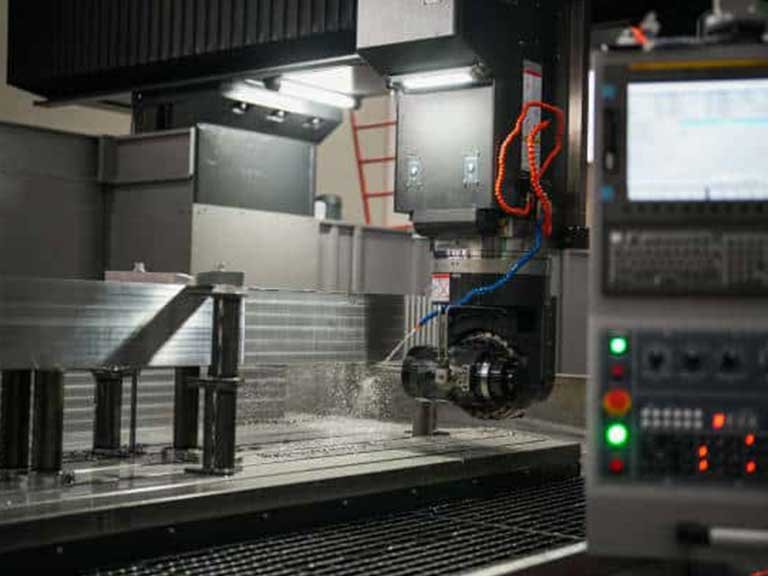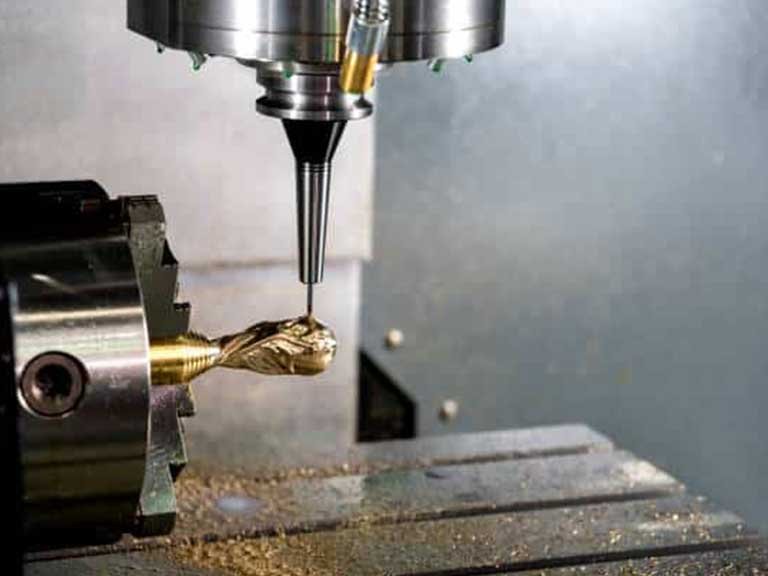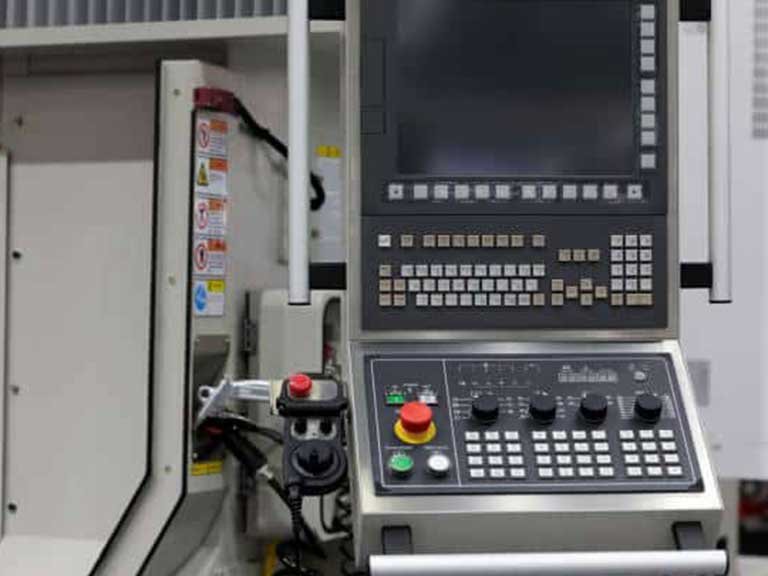5 Axis CNC machining represents a significant advancement in manufacturing technology. Compared to traditional 3 Axis CNC machining, 5 Axis technology improves machining precision and efficiency by adding two rotational axes (A-axis and B-axis). This technology allows us to produce parts with higher complexity and precision, meeting modern manufacturing needs for high tolerances and complex geometries.
Traditional 3 Axis CNC machining operates on the X, Y, and Z axes. While useful, it has limitations in handling complex and intricate parts. In contrast, 5 Axis CNC machining operates on five axes simultaneously, providing greater machining flexibility. This additional freedom allows cutting tools to approach the workpiece from almost any angle, significantly reducing the number of times a part needs to be repositioned, thereby improving production efficiency.
The technical advantages of 5 Axis CNC machining make it widely used across various industries. It is ideal for complex components in aerospace and automotive manufacturing and plays a crucial role in medical device production. Yonglihao Machinery uses this advanced technology to provide high-quality, customized solutions for various industries. In the following sections, we will explore how Yonglihao Machinery applies 5 Axis CNC machining technology to meet industry demands.
Table of Contents
Understanding 5-Axis CNC Machining
In 5-Axis CNC machining, a 5-Axis CNC machine offers an extra degree of freedom. This is compared to a traditional 3-axis machine. 5-Axis machines can move cutting tools in five different axes at the same time. They provide unmatched precision, versatility, and speed.
Yonglihao Machinery can provide customers with high-quality 5-axis CNC machining services. They can pivot a tool or workpiece in two extra planes, in addition to the standard X, Y, and Z axes. This allows for precise cuts. They can be made from any angle to create complex shapes and forms.
Unlike traditional 3-axis CNC machining, 3-axis machines can do many tasks well. But, they can only cut in three planes: up and down, left and right, and front and back. 5-axis machines add two types of rotation. They rotate around the X-axis (A-axis) and the Y-axis (B-axis), or sometimes the workpiece itself. This reduces set-up times and increases cutting speed and accuracy.
Choosing a state-of-the-art 5-axis machine means that it can machine multiple faces and complex parts in one set-up. This speeds up production. It also cuts errors from moving and re-fixing the workpiece many times. For industries where time is critical and accuracy is essential, this efficiency is vital.
Ready to get started on your next project? Get a personalized estimate for your parts machining needs.
Key Advantages of 5 Axis CNC Machining in Modern Manufacturing
This machining method can machine five different sides of a workpiece at the same time and is useful in many fields. Some of the advantages are lower costs and better machining results. The following are the main advantages of five-axis CNC machining:
Shorter Production Cycles
5 Axis CNC machines can complete multi-surface machining of complex parts in a single setup, drastically reducing production cycle times. Compared to 3 Axis machines, 5 Axis machines can machine from multiple angles, minimizing the need for multiple fixture setups and adjustments. This efficient machining method is crucial in the aerospace industry, where producing turbine blades and aircraft structures requires high precision and multiple machining processes. The aerospace sector’s demand for this technology is driving rapid growth in the global CNC machine tool market.
High Precision & Superior Surface Quality
5 Axis CNC machines excel in accessing workpieces from different angles, especially when dealing with curved surfaces and hard-to-reach areas. This capability results in higher machining precision and excellent surface finishes, as the additional rotational axes (A and B axes) minimize vibration during machining, ensuring smoother surface treatments. The medical industry utilizes this technology to manufacture precise implants and surgical tools, ensuring extremely high precision and surface quality to enhance patient safety and surgical success rates.
Increased Design Flexibility
5 Axis CNC machining offers significant design freedom, enabling designers and engineers to achieve more innovative and complex designs that are difficult to realize on 3 Axis machines. This flexibility allows for machining complex geometries, such as intricate surfaces, recessed structures, and deep cavities. The automotive industry widely adopts 5 Axis CNC machining to produce complex engine components and uniquely designed interior parts, improving functionality and aesthetics.
Cost-Effectiveness
Although 5 Axis CNC machines have a higher initial cost, they offer significant long-term cost benefits. By reducing multiple setups and processes, minimizing material waste, and lowering labor and subsequent processing costs, 5 Axis machines can reduce the production cost of each part. In the consumer electronics industry, manufacturers use 5 Axis CNC machines to produce high-precision components and housings, improving production efficiency, optimizing material use, and reducing waste costs.

High Precision and Consistency
When performing manual machining operations, more settings are required to achieve the best results. However, these additional settings often lead to design errors and deviations. This can easily lead to the machinist losing alignment during machining. 5-axis CNC machining, on the other hand, requires fewer settings. This eliminates the possibility of errors and improves precision.
Today, most machinists use 5-axis CNC machines. This means they don’t have to manually move the workpiece while cutting it. This ensures that the machining tolerances are even tighter. In addition, using shorter cutting tools in certain machine settings can extend the tool’s lifespan. And it ensures that they can be reused repeatedly.
Smoother Setup Operations
In general, it is easier to set up a 5-axis CNC machine than a 3-axis CNC machine. This is because a 5-axis CNC machine can machine five areas simultaneously. In addition, a 5-axis CNC machine only needs one setup to machine a shaped part. A normal 3-axis CNC machine, on the other hand, requires multiple setups to work on different faces.
Disadvantages of 5-axis CNC Machining
This CNC machining has many advantages and is very important for machining parts. However, 5-axis CNC machining is not perfect and does have some problems. The following problems can occur with 5-axis CNC machining:
It is Expensive
5-axis CNC machines are more expensive than 3-axis CNC machines. The same applies to the software required to operate the machine. In addition, 5-axis CNC machines are more difficult to maintain than other CNC machines. Therefore, one of the main disadvantages of 5-axis CNC machining is the price.
Programming Difficulty
Programming a 3-axis machine is different from programming a 5-axis machine. The main reason is that the addition of two circular motions makes the path of the composite motion more complex. For example, when setting up 5 axes, the movement of each axis must be considered to avoid collisions or interference. In addition, more complex codes are required to achieve better surface quality and accuracy.

Requires Higher Operating Skills
Numerous new technologies are used in 5-axis CNC machining. An experienced and professional operator is required to fully utilize the machine’s potential. Hiring a skilled operator also increases labor costs.
How 5 Axis CNC Machines Work: Structure and Functionality
5 Axis CNC machines expand the capabilities of traditional CNC machines by adding two rotational axes, typically the A-axis and B-axis. Unlike traditional machines limited to three axes (X, Y, Z), 5 Axis machines allow tool movement on five axes. The A-axis rotates around the X-axis (tilting the tool forward and backward), while the B-axis rotates around the Y-axis (tilting the tool left and right). This flexible movement allows the tool to approach the workpiece from any angle, significantly enhancing the precision and capability to machine complex parts.
Advantages of 5 Axis CNC Machining:
- High-Precision Machining: With 5 axis flexibility, machines handle complex shapes with minimal vibration and higher precision, crucial for parts requiring strict tolerances, such as turbine blades in aerospace and custom implants in medical devices.
- Complex Geometries: 5 Axis machines easily achieve complex geometries that 3 Axis machines cannot, such as recessed structures and intricate surfaces, allowing for more innovative designs.
The Importance of CAM Software at Yonglihao Machinery
The CAM software used by Yonglihao Machinery is crucial in 5 Axis CNC machining. This software manages the complex 5 Axis movements while controlling cutting paths, speeds, and tool selection. CAM software allows programmers to design efficient machining programs, avoid tool collisions, and optimize cutting paths. This ensures production efficiency and safety while reducing machining time and material waste.
Path Optimization: The software improves machining efficiency and surface finish by analyzing and optimizing paths, reducing subsequent processing steps.
Safety Assurance: Advanced software algorithms reduce the risk of tool-workpiece collisions, ensuring the safety of the machining process.

Types of 5-axis CNC Machine Tools
A 5-axis CNC machine tool can save you a lot of time. It can make your current workflow more suitable for certain tasks. There are different types of 5-axis CNC machine tools to meet the growing needs of the manufacturing industry. The way the rotary axes are arranged is what makes a 5-axis CNC machine tool unique.
Head/Head
In this type of CNC machine, the rotary axes are located in the head. As the 5-axis vertex is located on a specific platform, you do not have to worry about the tool in this part interfering with the machine spindle head. In addition, as the 5-axis vertex moves on a fixed table, it does not affect the workpiece. So you don’t have to worry about them interfering with each other.
This 5-axis machine design allows the head to move around the workpiece while machining it. Head/Head CNC machines are therefore ideal for machining large parts.
Table/Head
In this 5-axis CNC machine, there are usually two rotary axes. One rotary axis is in the head and the other is in the rotary table. Since the rotary axis is in the head, it can only turn within a certain range. On the other hand, the rotary axis placed on the table can turn anywhere.
One advantage of this setup over the head-to-head configuration is that there is no danger of hitting a limit. This is because the part is always rotating. On the other hand, the CNC machine can only process a certain number of parts because the part or workpiece is located on the rotary axis.
Table/Table
In this arrangement, both rotary axes are located on the table. The range of these rotary axes is severely restricted. This type of machine is therefore ideal for machining undercuts. Compared to other machine arrangements, Table/Table also has a smaller working range. On the other hand, it is also slower than other machines. This is because it is not equipped with dedicated motors. In addition, as they cannot bear much weight, they are not suitable for machining large or heavy parts.

What Parts Can Be Machined on a 5-axis CNC Machine?
With 5-axis CNC machines, many different parts can be machined. Often, these parts have complex shapes and designs. The following are some of the parts that can be machined with a 5-axis CNC machine.
Complex Surface Parts
As you can see, complex curved parts are widely used in electronics, aviation, and aerospace. It is difficult to machine such complex surfaces with conventional CNC machines. 5-axis CNC machines can machine spherical surfaces, turbine engine blades, marine propellers, impellers, and other complex curved shapes.
Disc Parts
5-axis CNC machines are also a great way to make drone parts. Disc parts and plate parts can be machined in this way. Especially those parts with end distribution holes or radial holes. In addition, it can be used to manufacture machine motor covers. Nevertheless, to perform 5-axis CNC machining of such parts, you need a horizontal or vertical machining center. The orientation of the holes determines which machining center to use.
Boxed Parts
Boxed parts are difficult to machine with conventional tools because they require multiple clamping and alignment. Since 5-axis machines can machine several surfaces at the same time. Therefore machining boxed parts is easier and more accurate.
Special-Shaped Parts
Parts with irregular shapes are called “special-shaped parts”. For example, workpieces consisting of lines, surfaces, and points. It is difficult, if not impossible, to machine this type of part by normal machining methods. This is because it is difficult to control the clamping pressure during the process. 5-axis CNC machining, on the other hand, can be easily accomplished with multiple stations.

Applications of 5 Axis CNC Machining in Specific Industries
Aerospace Industry
In the aerospace industry solutions, 5-axis CNC machining is widely used to manufacture complex, high-precision parts such as engine components and aircraft structures. Aerospace parts often have complex curved surfaces and hard-to-reach corners, which only 5 Axis machining can achieve with the required precision and quality. Airlines use 5 Axis CNC machining technology to manufacture turbine blades and wing components, demanding extreme precision and reliability to ensure flight safety and efficiency. According to market research, the application of 5 Axis machining technology in aerospace has improved production efficiency and reduced clamping errors.
Medical Equipment Industry
This CNC machining is crucial in medical industry solutions, used to produce custom implants and surgical tools that require high precision and excellent surface treatment. Through 5 Axis machining, manufacturers can produce ergonomic implants such as hip and knee joints with complex surfaces and precise dimensions that perfectly match the human body. Precise machining and high-quality surface treatment are essential to ensure patient safety and surgical success, which is why 5 Axis CNC machining is widely adopted in the medical industry.
Automotive Manufacturing Industry
In the automotive industry solutions, 5 Axis CNC machining is used to manufacture complex engine parts and custom high-performance components. 5 Axis technology speeds up production and provides greater manufacturing flexibility, enabling automakers to quickly respond to market changes and offer high-performance, customized solutions. For example, 5 Axis machining plays an important role in producing complex cylinder blocks and high-performance exhaust manifolds for car engines. These parts require precise geometries and high-quality surface treatments to enhance vehicle performance and fuel efficiency. Reports from the automotive industry show significant improvements in production efficiency and product development speed with the adoption of 5 Axis CNC machining technology.
5-Axis CNC Machining Challenges and Considerations
This CNC machining has clear advantages but also faces challenges, including high initial costs, complex programming, and high operator skill requirements. Yonglihao Machinery addresses these challenges through continual investment in technology, comprehensive staff training, and full customer support. The company ensures its employees systematically acquire advanced skills in 5-axis CNC machining and simplifies programming using advanced CAM software and efficient workflows. This approach boosts productivity and keeps costs low.
Over the past 10 years, the Yonglihao Machinery team has provided effective manufacturing solutions to the aerospace, medical, and automotive industries. We have leveraged advanced 5-axis CNC machining technology and strong team management to successfully overcome the challenges associated with it.

Case Study
Yonglihao Machinery has recently completed a custom parts order for the German aerospace industry. The order needed the production of complex engine parts. These parts have complex designs. They need very high accuracy and finish. This poses a huge challenge to making them. Advanced 5-axis CNC technology was used. It carried out a one-time machining, avoiding multiple clamping and positioning. It greatly improved production efficiency and accuracy. The final result was highly recognized by the customer.
Future Trends in 5 Axis CNC Machining
With continuous technological advancements, 5 Axis CNC machining is poised for significant development in the future. Current trends include applying artificial intelligence (AI) and machine learning in CNC machining, which optimize cutting paths and tool life by analyzing data to improve machining precision and efficiency. AI can monitor changes in the machining process in real time, automatically adjusting parameters to reduce errors and material waste. This intelligent machining approach will significantly enhance production efficiency and reduce operating costs.
Moreover, the design of 5 Axis CNC machines is evolving towards more lightweight and efficient models. The use of new materials not only improves the durability and precision of machines but also reduces energy consumption, making 5 Axis CNC machining more environmentally friendly. This progress enables 5 Axis CNC machines to handle more complex geometries and a broader range of materials.
Yonglihao Machinery is committed to innovation in 5 Axis CNC machining, continuously pushing the company’s development at the technological forefront. We are dedicated to introducing more efficient and precise machining solutions to meet the ever-growing customer demands in future manufacturing. By integrating the latest AI technology and machine learning, Yonglihao Machinery enhances its competitiveness and provides clients with forward-looking, high-quality machining services.
Conclusion
5-axis CNC machining technology is key. It improves modern manufacturing with its great precision, flexibility, and efficiency. The success story of Yonglihao Machinery is more proof of its expertise and innovation. We make high-end manufacturing solutions. Feel free to get in touch with our team for the best part customization solutions for any of your CNC machining service needs.
FAQ
What is CNC machining?
CNC stands for computer numerical control, which refers to the use of computers to automate machine tools. This means that the process uses computer programs to control machine tools such as lathes, milling machines, and grinders. This technology improves the accuracy, efficiency, and consistency of parts and product production.
What are the advantages of 5 Axis CNC Machining?
Advantages of 5 Axis CNC machining include higher precision, shorter production cycles, the ability to machine more complex geometries, and fewer setups.
Which industries use 5 Axis CNC Machining?
Industries such as aerospace, automotive manufacturing, medical equipment, and electronics widely use 5 Axis CNC machining to manufacture complex and precise parts.
How does 5 Axis CNC Machining differ from 3 Axis CNC Machining?
5 Axis CNC machining adds two rotational axes, allowing it to machine more complex shapes, reduce setup time, and improve machining precision.
What challenges does 5 Axis CNC Machining face?
Challenges of 5 Axis CNC machining include high initial costs, complex programming requirements, and the need for skilled operators.

